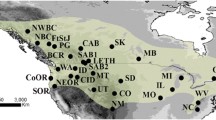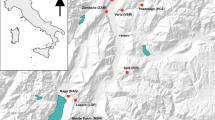Abstract
From analyses of published data and a review of the literature, I studied indirect and direct measures of gene flow among populations of Columbian ground squirrels, Spermophilus columbianus. New analyses were used to examine an allozyme data set (seven polymorphic loci) that had been collected by Zammuto and Millar (1985a) from six populations of ground squirrels that were spread over 183 km. G-tests indicated significant variation in allele frequencies among populations, but F-statistics revealed relatively little population differentiation (average F ST=0.026). F ST values were used to estimate rates of gene flow indirectly and indicated fairly high rates of gene flow (average N e m=13.5). Recorded dispersal distances of individual ground squirrels were fairly short (most<4 km, maximum recorded distance was 8.5 km), and the minimum distance between populations used to create the allozyme data set was about 25 km. Thus, direct dispersal among the populations in the allozyme data set was highly unlikely. Small genetically effective populations may have experienced high rates of migration over short distances (about 43% of adults in local populations were immigrants), however, resulting in homogeneous allele frequencies over the geographic range. This explanation provides an alternative to invoking gene flow in the recent past to explain discrepancies between dispersal distances in the field and homogenization of allele frequencies over large ranges, Mammalian species that have virtually complete dispersal of subadult males from the natal area might be expected to exhibit relatively high rates of gene flow, regardless of actual dispersal distances. Genetically effective populations may be much smaller than more extensive ecological populations and experience higher rates of gene flow.
Similar content being viewed by others
References
Allendorf FW, Phelps SR (1981) Use of allelic frequencies to describe population structure. Can J Fish Aquat Sci 38:1507–1514
Boag DA, Murie JO (1981) Population ecology of Columbian ground squirrels in southwestern Alberta. Can J Zool 59:2230–2240
Caccone A (1985) Gene flow in cave arthropods: a qualitative and quantitative approach. Evolution 39:1223–1235
Chesser RK (1991a) Gene diversity and female philopathy. Genetics 127:437–447
Chesser RK (1991b) Influence of gene flow and breeding tactics on gene diversity within populations. Genetics 129:573–583
Daly JC, Patton JL (1990) Dispersal, gene flow, and allelic diversity between local populations of Thomomys bottae pocket gophers in the coastal ranges of California. Evolution 44:1283–1294
Dobson FS (1982) Competition for mates and predominant juvenile male dispersal in mammals. Anim Behav 30:1183–1192
Dobson FS, Kjelgaard JD (1985) The influence of food resources on population dynamics in Columbian ground squirrels. Can J Zool 63:2095–2104
Dobson FS, Murie JO (1987) Interpretation of intraspecific life history patterns: evidence from Columbian ground squirrels. Am Nat 129:382–397
Easteal S (1985) The ecological genetics of introduced populations of the giant toad Bufo marinus. II. Effective population size. Genetics 110:107–122
Easteal S, Floyd RB (1986) The ecological genetics of introduced populations of the giant toad, Bufo marinus (Amphibia: Anura): dispersal and neighbourhood size. Biol J Linn Soc 27:17–45
Ehrlich PR, White RR, Singer MC, McKechnie SW, Gilbert LE (1975) Checkerspot butterflies: a historical perspective. Science. 188:221–228
Endler JA (1977) Geographic variation, speciation, and clines. Princeton University Press, Princeton, NJ
Endler JA (1979) Gene flow and life history patterns. Genetics 93:263–284
Festa-Bianchet M, King WJ (1984) Behavior and dispersal of yearling Columbian ground squirrels. Can J Zool 62:161–167
Gilbert LE, Singer MC (1973) Dispersal and gene flow in a butterfly species. Am Nat 107:58–72
Greenwood PJ (1980) Mating systems, philopatry, and dispersal in birds and mammals. Anim Behav 28:1140–1162
Hackett DF (1987) Dispersal of yearling Columbian ground squirrels. Doctoral Dissertation, University of Alberta, Edmonton
Johnson MS, Clarke B, Murray J (1988) Discrepancies in the estimation of gene flow in Partula. Genetics 120:233–238
King WJ, Murie JO (1985) Temporal overlap of female kin in Columbian ground squirrels (Spermophilus columbianus). Behav Ecol Sociobiol 16:337–341
Long JC (1986) The allelic correlation structure of Gainj- and Kalam-speaking people. I. The estimation and interpretation of Wright's F-statistics. Genetics 112:629–647
McKechnie SW, Ehrlich PR, White RR (1975) Population genetics of Euphydryas butterflies. I. Genetic variation and the neutrality hypothesis. Genetics 81:571–594
Murie JO, Harris MA (1978) Territoriality and dominance in male Columbian ground squirrels (Spermophilus columbianus). Can J Zool 56:2402–2412
Murie JO, Harris MA (1984) The history of individuals in a population of Columbian ground squirrels: source, settlement, and site attachment. In: Murie JO, Michener GR (eds) The biology of ground-dwelling squirrels. University of Nebraska Press, Lincoln, pp 353–373
Murie JO, Harris MA (1988) Social interactions and dominance relationships between female and male Columbian ground squirrels. Can J Zool 66:1414–1420
Patton JL, Feder JH (1981) Microspatial genetic heterogeneity in pocket gophers: non-random breeding and drift. Evolution 35:912–920
Slatkin M (1981) Fixation probabilities and fixation times in a subdivided population. Evolution 35:477–488
Slatkin M (1985) Gene flow in natural populations. Annu Rev Ecol Syst 16:393–430
Slatkin M (1987) Gene flow and the geographic structure of natural populations. Science 236:787–792
Slatkin M, Barton NH (1989) A comparison of three indirect methods for estimating average levels of gene flow. Evolution 43:1349–1368
Sokal RR, Rohlf FJ (1981) Biometry, 2nd edn. Freeman, San Francisco, Calif.
Via S, Lande R, 1985) Genotype-environmental interaction and the evolution of phenotypic plasticity. Evolution 39:505–522
Wade MJ (1982) Group selection: migration and the differentiation of small populations. Evolution 36:949–961
Wade MJ, McCauley DE (1984) Group selection: the interaction of local deme size and migration in the differentiation of small populations. Evolution 38:1047–1058
Waser PM, Elliott LF (1991) Dispersal and genetic structure in kangaroo rats. Evolution 45:935–943
Wiggett DR (1988) Natal dispersal in Columbian ground squirrels. MSc thesis, University of Alberta, Edmonton
Wiggett DR, Boag DA (1989) Establishing colonies of squirrels during their active season. Wildl Soc Bull 14:288–291
Wiggett DR, Boag DA (1989) Intercolony natal dispersal in the Columbian ground squirrel. Can J Zool 67:42–50
Wiggett DR, Boag DA (1992) The resident fitness hypothesis and dispersal by yearling female Columbian ground squirrels. Can J Zool 70:1984–1994
Wright S (1969) Evolution and the genetics of populations, vol 2. The theory of gene frequencies. University of Chicago Press, Chicago, Ill.
Zammuto RM (1983) Effects of a climatic gradient on Columbian ground squirrel (Spermophilus columbianus) life history. Doctoral dissertation, University of Western Ontario, London, Ontario
Zammuto RM, Millar JS (1985a) Environmental predictability, variability and Spermophilus columbianus life history over an elevational gradient. Ecology 66:1784–1794
Zammuto RM, Millar JS (1985b) A consideration of bet-hedging in Spermophilus columbianus. J Mamm 66:652–660
Author information
Authors and Affiliations
Rights and permissions
About this article
Cite this article
Dobson, F.S. Measures of gene flow in the Columbian ground squirrel. Oecologia 100, 190–195 (1994). https://doi.org/10.1007/BF00317146
Received:
Accepted:
Issue Date:
DOI: https://doi.org/10.1007/BF00317146




